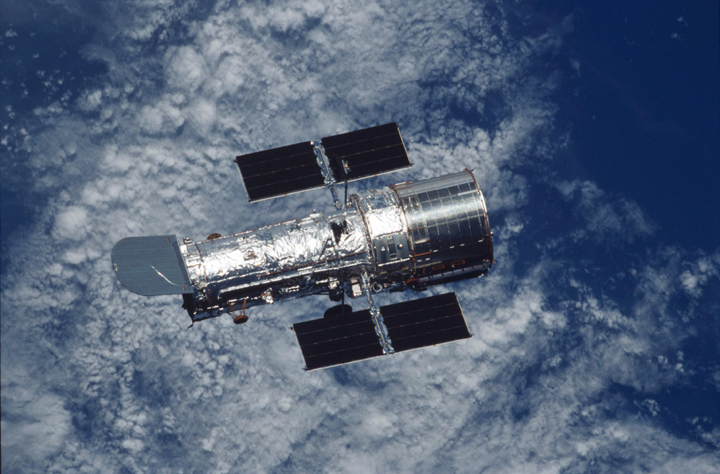
Hubble Space Telescope
The Hubble Space Telescope (HST) heads back toward its normal routine, after a week of servicing and upgrading by the STS-109 astronaut crew on board the Space Shuttle Columbia in March 2002.
Credit: NASA
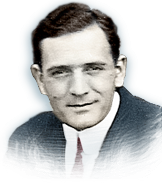
Edwin Hubble
 My name is Edwin Hubble, and my life has been dedicated to understanding how big the Universe really is. For a long time people assumed our galaxy made up the entire cosmos, but I sensed there were questions still to be answered. Are there other galaxies out there? How many galaxies are there in the Universe? How far away are they?
My name is Edwin Hubble, and my life has been dedicated to understanding how big the Universe really is. For a long time people assumed our galaxy made up the entire cosmos, but I sensed there were questions still to be answered. Are there other galaxies out there? How many galaxies are there in the Universe? How far away are they?
Using the large telescope at Mount Wilson in California, I searched for the answers to these questions. Night after night after night you would find me in the observatory, staring at blurry, fuzzy, cloud-like masses. I took many photographs of these extragalactic phenomena. As I pored over them I asked myself "Is our Milky Way Galaxy the whole Universe, or are there other galaxies out there ?"
After years of photographing and studying the night skies, I came to the conclusion that the Universe is constantly expanding and that it contains billions of galaxies. Because of these and other discoveries, the Hubble Space Telescope (HST) was named for me .

The Hubble Space Telescope (HST) heads back toward its normal routine, after a week of servicing and upgrading by the STS-109 astronaut crew on board the Space Shuttle Columbia in March 2002.
Credit: NASA
The Hubble Space Telescope was launched in 1990, taken to space in the cargo bay of the space shuttle Discovery. Its main purpose was to figure out a distance scale of the Universe (how big it is) and where the elements present in space came from. That is what interests scientists. But the pictures it takes! That's what intrigues most of humanity .
But the HST did not just happen. Centuries of work by curious astronomers led to its conception. As Isaac Newton said, "If I can see farther, it is because I am standing on the shoulders of giants." The Hubble Space Telescope can make the same claim. Here is a short history of events and inventors that led to its development .
"Equipped with his five senses, man explores the Universe around him and calls the adventure Science." - Edwin Hubble.
Tell about a time when you used each of your senses to figure out something about the world or the Universe.
At some point between 1508 and 1514, a Polish astronomer, Nicolaus Copernicus, announced that the planets revolved, not around the Earth as everyone believed but around the Sun. He watched the skies with only his eyes since a hundred more years were to pass before the telescope was invented.
On November 11, 1572, Tycho Brahe, a Danish astronomer, used accurate calculations to show that a bright light in the night sky was not a nearby comet but was, in fact, a supernova, or exploding star, that was as distant as the other stars. By the year 1600, he had measured the positions of the planets along their orbits and the apparently fixed positions of more than 777 stars .
The first devices used to pinpoint and measure the stars were crude, awkward "parallactic instruments." This apparatus was made of three rulers fixed together in a triangular figure. The purpose of the rulers was to measure a star's zenith, or the highest point a star reaches above the horizon. With spherical trigonometry, early astronomers used these zenith distances to calculate a star's longitude and latitude, and thus fix its position in the sky.
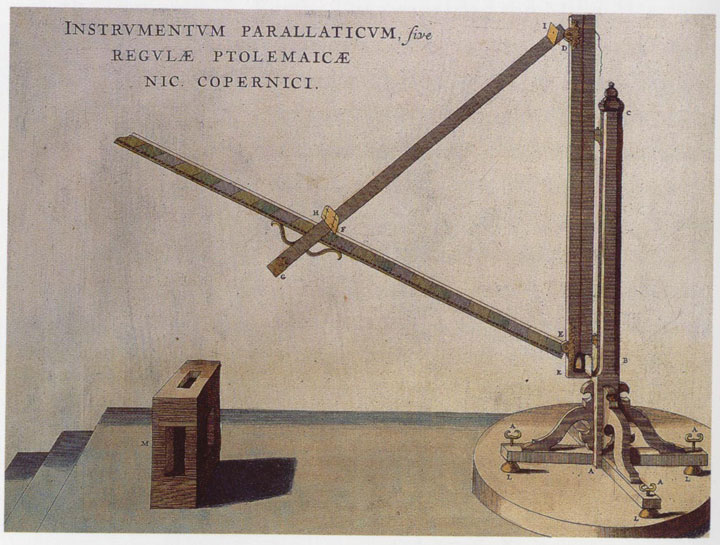
What could be easier than observing the stars? People have always looked skyward, but locating the stars precisely and measuring their positions is no simple task. For many measurements, early astronomers relied on an awkward parallactic instrument. This instrument measured the distance of a star from the zenith (the point directly overhead), which would be used to calculate its longitude and latitude.
Credit: Adler Planetarium & Astronomy Museum
The astrolabe is a very ancient astronomical device that is adjusted to show how the sky looks at a specific place at a given time. Astronomers used it to find the time of sunrise and sunset and, thus, how long the day was, and to locate celestial objects in the sky. This was done by drawing the sky on the face of the astrolabe and marking it so positions in the sky are easy to find .
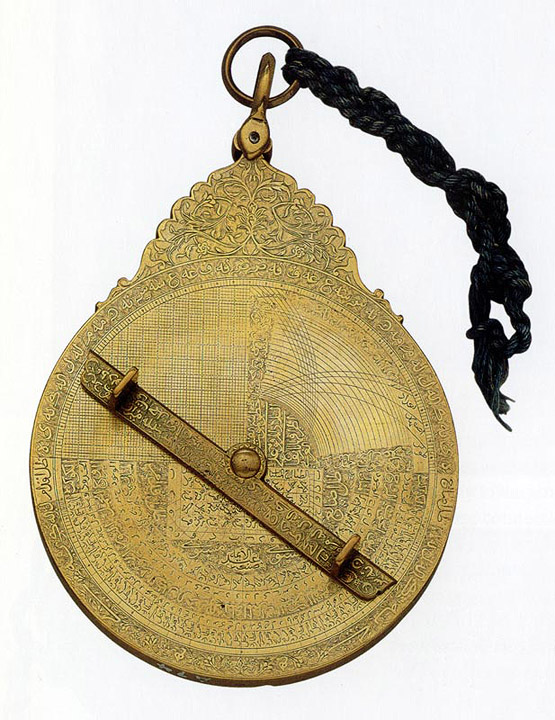
The astrolabe is a historical astronomical instrument. It was used for locating and predicting the positions of the Sun, Moon, planets and stars. The sight on the back of an astrolabe allowed early astronomers to measure the altitude of a star above the horizon.
Credit: Adler Planetarium & Astronomy Museum
The quadrant is another early measuring instrument used by astronomers. By sighting along a quadrant's edge, early astronomers focused on a star's altitude above the horizon. A string or metal strip would hang straight down, pulled by gravity, against a curved, carved scale. While holding the quadrant in one hand, the astronomer clamped the string or metal strip against the scale with the other hand and read the number that told the height. By the 1600s, astronomical quadrants sometimes carried telescopic sights, and even micrometers, for increased accuracy .
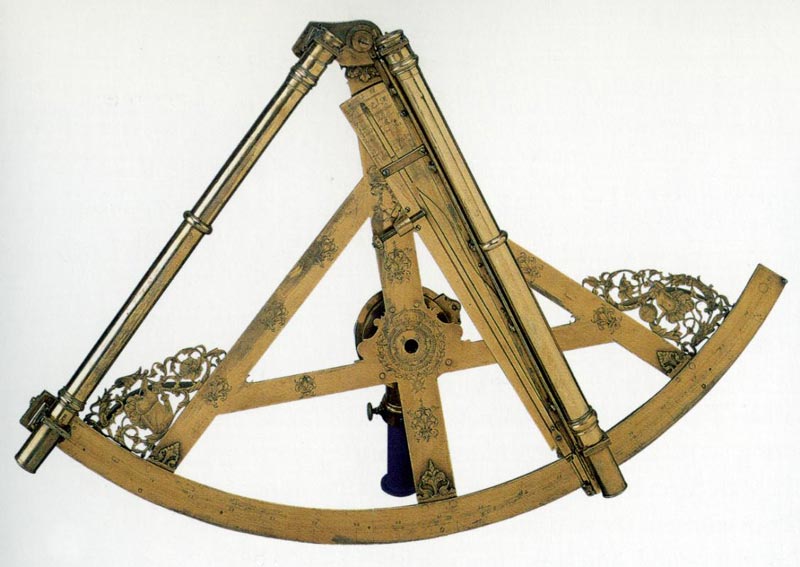
The sight along the edge of the quadrant allowed early astronomers to measure the altitude of a star above the horizon. By the 1600s, astronomical quadrants sometimes carried telescopic sights for increased accuracy.
Credit: Adler Planetarium & Astronomy Museum
Astronomers needed more accuracy from their quadrants. Their solution was to make them bigger. That way the user could read smaller graduations on the scale when measuring a star's position. Skilled artisans were employed to make exceptionally large quadrants that were permanently fastened (for stability) on north-south walls. Since they were part of the wall they were called mural quadrants and were part of elaborate decorations. By using a clock alongside the mural quadrant, an astronomer could measure the time and altitude of a star from which he could calculate its exact position.

The obvious way to make a simple instrument more accurate was to make it bigger. This allowed its user to read finer graduations on the scale when measuring the position of a star. Skilled artisans made very large mural quadrants that were mounted permanently on north-south walls. By using a clock alongside a mural quadrant, an astronomer could measure the time and altitude of a star when it was directly overhead. Using these measurements, the astronomer could calculate a the exact position of a star. This mural quadrant of the Danish astronomer Tycho Brahe (1546-1601) included a portrait of his household.
Credit: Adler Planetarium & Astronomy Museum
The scientists and astronomers who studied the heavens did so because they were drawn to the mystery of it. There was no way they could fail to learn. What would you try to do if you knew you could not fail?
Around 1608, a Dutch eyeglass maker, Hans Lippershey, assembled one of the early telescopes. While he surely was not the first to make one, he did, however, tell a lot of people about it and the news spread across Europe.
The first astronomer to use a telescope was the great Italian scientist, Galileo Galilei in 1609. It was he who first saw the craters of the moon, sunspots, the four large moons of Jupiter, and the rings of Saturn.
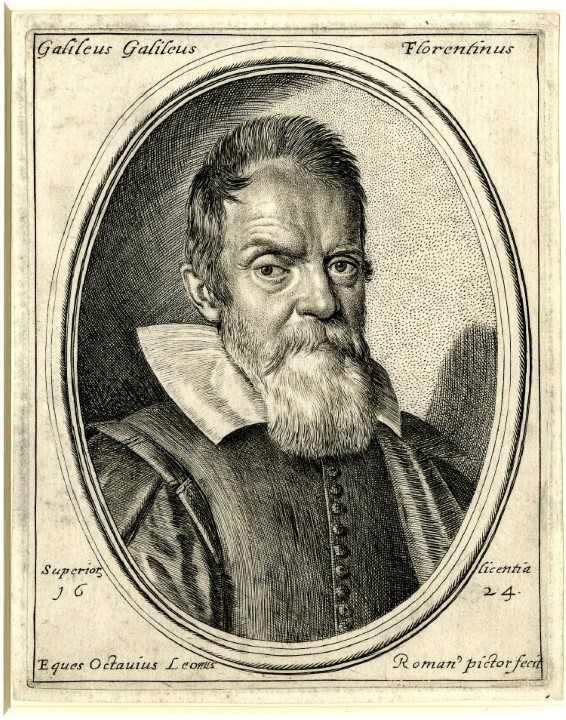
Italian astronomer, mathematician, and physicist. Galileo laid the foundation for modern experimental science by his investigation of natural laws. He also expanded humanity's vision and understanding of the universe by constructing astronomical telescopes. Galileo is also remembered for giving a mathematical formulation to many physical laws.
Credit: © The Trustees of the British Museum
Galileo's telescope used a group of glass lenses to magnify objects. The glass lenses in the Galileo telescope weren't very clear, however. They were full of little bubbles and had a greenish tinge because it was difficult to refine all the iron particles out of the sand used in the glass making process. Another problem was that the shape of the glass lenses gave the field of view very fuzzy edges.
While this refracting telescope gave 30 times magnification, Galileo could see only a very narrow image. A mere quarter of the moon's face could be observed before the rotation of the Earth moved the telescope off its position. Then he had to move his telescope to observe a different area .
As crude as they were, refracting telescopes opened the skies. They displayed a Universe that is unimaginably huge. Yet the same rules that operate on Earth hold true "out there." Early telescopes were skinny for a good reason. To increase how large objects looked, light had to be focused farther and farther behind the primary lens, which resulted in longer and longer telescopes. Longer telescopes then required larger lenses, and after a lens reached 1 meter in diameter it would deform, sagging under its own weight. The largest telescope with a lens objective (first glass that light hits) is at the Yerkes Observatory in Williams Bay, Wisconsin .
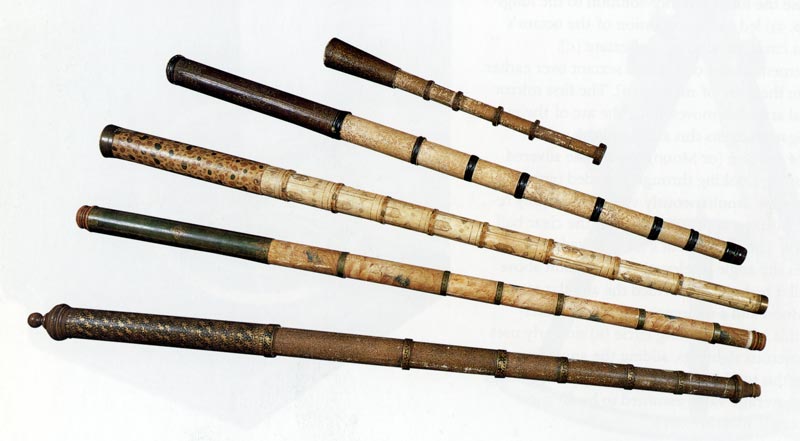
Early telescopes were skinny compared with the giant instruments astronomers use today, but for good reason. Unless they are quite thin, simple lenses distort images. Thin lenses require a greater distance to bring an image into focus. The image shows some examples of early telescopes. The telescope opened the skies to deeper scrutiny. The universe it revealed is unimaginably huge, yet it works by the same rules that operate on Earth.
Credit: Adler Planetarium & Astronomy Museum
Johannes Kepler, an assistant to Tycho Brahe, became interested in the telescope and how it works. After writing a paper on how light enters the human eye and is focused, Kepler used this information to improve the design of the telescope. His idea was to have two curved lenses, which made the image upside down. Kepler's design is still used to make refractors today, though there have been improvements in the lenses and the glass.
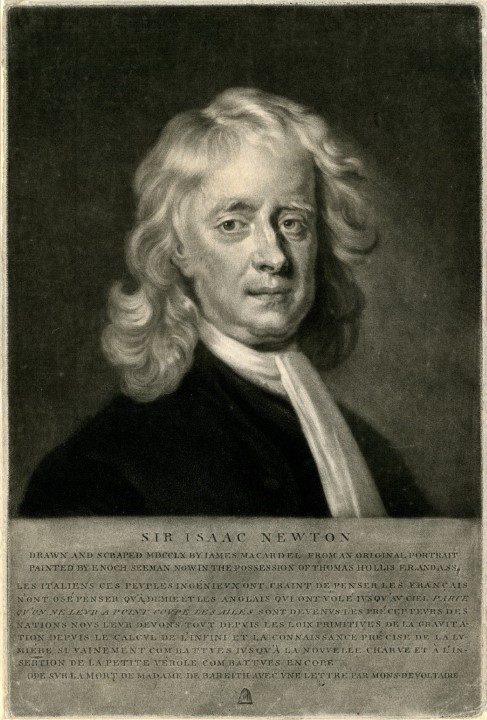
English mathematician and natural philosopher (physicist). He discovered the law of universal gravitation, began to develop the calculus, and discovered that white light is composed of all the colors of the spectrum. These findings enabled him to make fundamental contributions to mathematics, astronomy, and theoretical and experimental physics.
Credit: © Trustees of the British Museum
While scientists were getting better and better views of the Universe, when they looked through a refracting telescope, rings of different colors often surrounded the images. Isaac Newton did many experiments with light and his discoveries explained this phenomenon. He found that white light is actually made up of different colors - red, orange, yellow, green, blue, indigo and violet. Curved lenses split white light into an established order of the colors of the spectrum.
To demonstrate this, Newton let a narrow beam of sunlight pass through a small hole in a window shutter and then through a prism. The white light refracted into an oblong spectrum on a board. Then, Newton selected one of these spectral colors (for example, red) and allowed only that color to pass through yet another small opening to a second prism. Newton watched to see what would happen when that color was refracted onto a second board.

As white light travels through a prism, the waves of light are refracted. Each color of light has a slightly different wavelength and the longer wavelengths (red) bend at a lesser angle than the shorter wavelengths (blue). The result is the separation of the wavelengths by color forming a rainbow. Conversely, a second prism could combine all the wavelengths back into white light.
Credit: NASA
What Newton found was that the color leaving the first prism could not be separated any further by the second prism. He concluded that white light is an assorted mixture of colors that cannot be individually changed in any way.
I used the knowledge of spectrum color order to determine if a galaxy was moving toward or away from the Milky Way Galaxy. But we'll get to that later!
"The most exciting phrase to hear in science, the one that announces new discoveries, is not 'Eureka!' (I've found it!), but 'That's funny...'" — Isaac Asimov.
Tell about a scientist who made a discovery because something didn't look quite right.
Building on what he had learned about light, Isaac Newton set out to remove the lenses from a telescope and search for material that would reflect light instead. He tried several different mixtures of metal, finally deciding on a ratio of six parts copper to two parts tin. This combination was almost as bright as silver but much less expensive and not as quick to corrode. The more light the mirror reflected, Newton knew, the better view the telescope would provide of the sky.
To construct the telescope, Newton placed a curved mirror at the bottom of the tube. That mirror sent reflected light forward to a second, smaller, flat mirror. This second mirror was angled to deflect the light rays to the eyepiece. With this design, Newton decreased the length of the telescope and eliminated the problem of light refracting, since the light didn't pass through lenses. The Hubble Space Telescope is a reflecting telescope.
Even though Newton invented the reflecting telescope to study what he knew about light, by 1730 astronomers were using it to study the Universe. They found that the bigger the mirror, the more light it reflected. These scientists began to build huge telescopes again, with larger and larger mirrors that reflected more and more light. Now it was the size of the primary mirror, not the distance between lenses that described how powerful a telescope was.
In 1772, Sir William Herschel became interested in astronomy. He combined different amounts of copper, tin, and other metals to find a mixture that improved reflection by 60 percent. The first telescope he made was seven feet long and had a 6-inch diameter mirror. It magnified what he looked at by 40 times.

In 1781 the telescope revealed another surprise. Using a reflecting telescope of his own design, astronomer and musician William Herschel (1738-1822) noticed an unusual object. He thought it was a comet, but astronomers showed that it was actually a new planet orbiting far beyond Saturn. Herschel named it in honor of King George III of England, but others called it Herschel after its discoverer. It took astronomers about 50 years to agree to name it Uranus, after the mythological father of Jupiter. In addition to the planet Uranus, Herschel discovered many new nebulae, clusters of stars, and he was the first person to correctly describe the spiral form of our Galaxy, The Milky Way.
Credit: Adler Planetarium & Astronomy Museum
Herschel could clearly see Saturn's rings with his new telescope. But if a little is good, then a lot is better, Herschel thought. Knowing that a telescope's most important quality was its ability to gather light, he built a telescope with a mirror diameter of nine inches and a length of 10 feet. Then he built one that was 20 feet long with a mirror diameter of 18 inches. In his mind there was no limit to the improvements he could make and the objects he would be able to see.
By 1781 Herschel had designed a 30-foot-long telescope. But the mirrors needed for this telescope were more than the local foundry could handle. Herschel set up the equipment in the basement of his home and prepared to pour the disks himself. The first mirror he cast cracked, and the second attempt broke the mold, spreading the liquid metal over the floor. But that didn't stop him. Herschel's greatest design was a completed 40-foot telescope with a mirror diameter of 48 inches. William Parsons, the third Earl of Rosse, was an avid amateur astronomer in Ireland. His dream was to build the world's largest telescope with a mirror six feet in diameter.
Each improvement in the telescope grew from the function and workings of the current optical instrument. Which improvement do you think was the most important, and why?
The reflecting telescopes made in the 18th and 19th centuries had different problems than refracting telescopes. While the mirrors made of the tin and copper alloy were easier to make than grinding lenses, these metal mirrors tended to discolor, which meant they had to be polished quite often. The astronomers also ran into a physics problem. Because the mirrors and the telescopes that held them were so very large, scientists found the huge instruments difficult to move. Changing the field of view to a new area of the sky was slow and time-consuming.
By the mid-1800s, astronomers decided that it wasn't the telescopes but the atmosphere that caused distant objects to still look hazy. They realized that as light passes through the air, it bends in unpredictable ways. With the unaided eye, this is what makes stars appear to twinkle. But when you use a telescope, this bending light just makes images look blurry, kind of how things appear when you look up from under water.
It was this problem of not being able to clearly focus distant images that led to the development of the Hubble Space Telescope.
To be a successful astronomer, you had to be awake when the stars were out. How do you think astronomers in the 16th through 19th centuries supported themselves and their families?